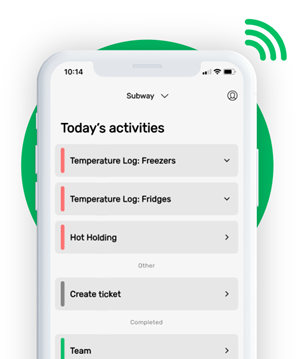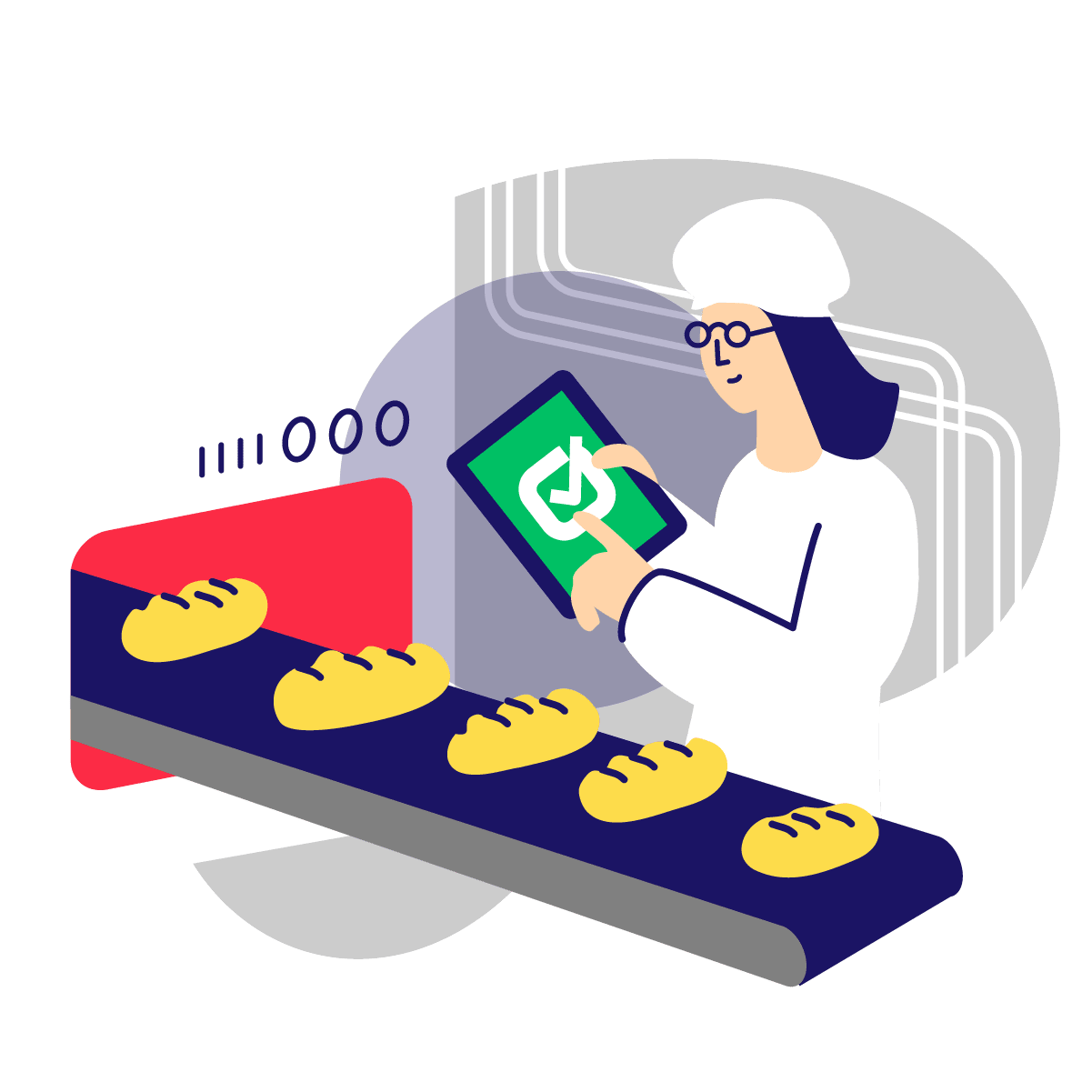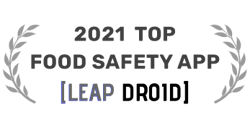FOOD TEMPERATURE CHART
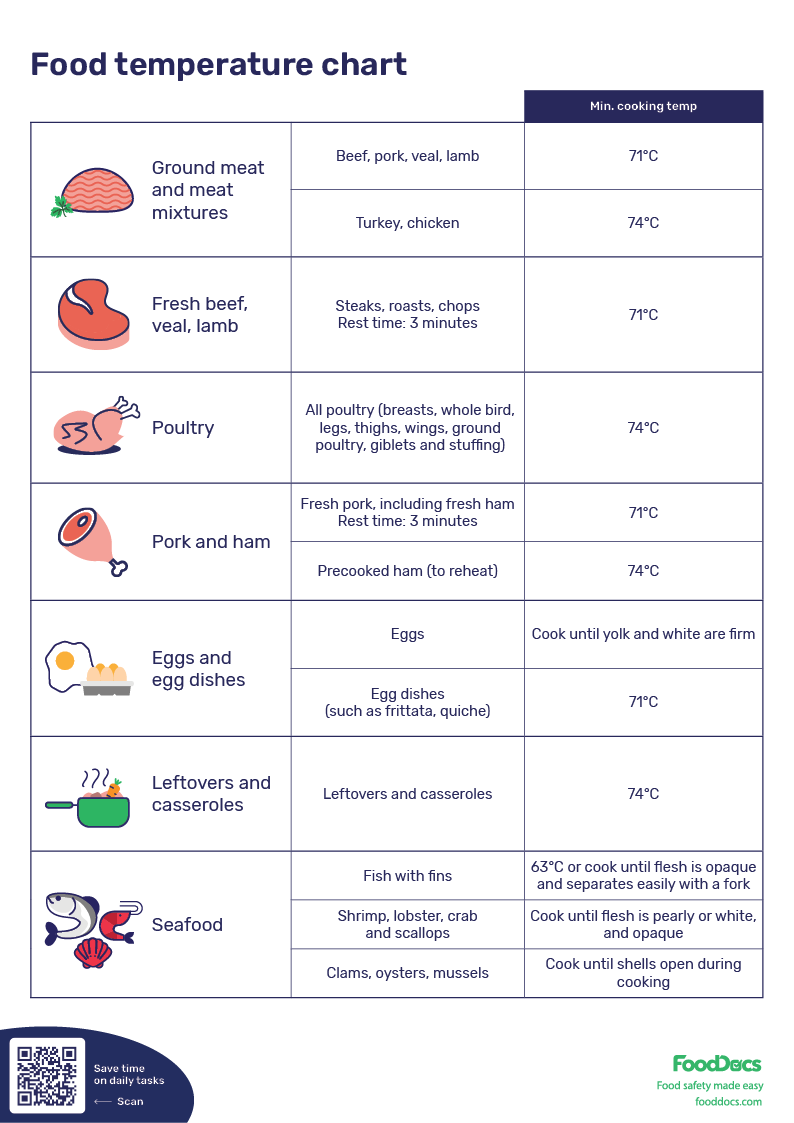

This is how our Digital Food Safety platform saves 20% of your time on daily tasks:
- Get upcoming task notifications
- Add data into the app
- Check the status of tasks in real-time

When food safety was still handled on paper, I typically spent a couple of hours per day getting the papers and going around checking or completing tasks… Now I can sit down and it's just all there in one place. It takes me 5-10 minutes.
Ruth B.
Store Manager
A food temperature chart complements cooking methods by helping people ensure that any perishable food item is safe for consumption. This step is an absolute food safety necessity. During any cooking process, the target quality must be achieved together with target safety.
This can only be achieved if food handlers cook specific food to the correct internal temperature and adequate cooking time such as reaching USDA-recommended safe internal temperatures of 165°F for poultry. Make sure that you get these tasks right using a friendly food thermometer and a food temperature chart.
Key takeaways
-
Cooking methods such as frying, baking, and grilling enhance food flavors, textures, and safety by reaching necessary internal temperatures.
-
It's vital for food safety to cook food to the correct internal temperature, using tools like a food thermometer and temperature charts.
-
Proper cooking is a crucial food handling practice to reduce the risk of foodborne illnesses such as those caused by undercooked foods contaminated with pathogens like Salmonella.
-
A food temperature chart is essential for food handlers to ensure every type of food reaches safe internal temperatures, crucial for preventing foodborne illnesses.
-
Various foods require different cooking temperatures; for example, poultry must reach 74°C, while pork, beef, and veal must reach 71°C.
-
Using a calibrated cooking thermometer and a food temperature chart helps achieve and verify the correct internal temperatures during cooking.
-
Food establishments, including restaurants and grocery stores, benefit from using a food temperature chart to guide proper cooking and consumer safety.
-
A food temperature chart serves multiple roles in a food establishment, acting as a reference guide, cost-saving tool, and a critical component of food safety training.
-
Creating an effective food temperature chart requires it to be accurate, brief, updated, and clear, based on reliable food safety sources.
-
FoodDocs' food safety management software makes compliance with standards easy by automating monitoring and ensuring tasks are completed on time, improving overall efficiency and sustainability.
One of the most important food handling practices in the food industry is proper cooking. The chances of getting a foodborne illness from consuming undercooked foods are very high.
The Centers for Disease Control and Prevention highlighted that 1 in every 25 packages of chicken products and other poultry, such as whole and ground chicken, at a food store may be contaminated with Salmonella. As some dangerous bacteria naturally live on the surface of any raw food, cooking them correctly is an essential task.
What is a food temperature chart?
A food temperature chart is a tool that can be used by every food handler as a reference for properly cooking different types of food to the correct internal temperature. Food safety heavily relies on the absence of pathogenic hazards.
A food temperature chart typically lists safe minimum internal cooking temperatures for various foods (meat, poultry, seafood, eggs, etc.) as set by governmental food safety authorities.
Bacteria in food can be a result of cross-contamination, poor food handling practices, and even poor sanitation environments. Although cooking can minimize or remove these foodborne bacteria and other pathogens, this operation relies on whether it is done correctly or not.
Any type of food needs to be thoroughly cooked to ensure that any potential food safety hazard is eliminated. This is a basic food handling practice together with using separate cutting boards for preparing foods as well as washing your hands with warm, soapy water and using a clean cloth towel to dry.
Because of the complexity and target pathogens in food, the target endpoint cooking temperature of foods may vary from one type to another. That is, whole or ground poultry that is commonly known to be susceptible to Salmonella contamination must be cooked up to a food-safe cooking temperature of 165°F (74°C).
On the other hand, ground pork, beef, and veal only require 160°F (71°C) of cooking temperature with an additional cooking process from the residual heat of the food for carryover cooking to ensure doneness and safety.
Measuring the internal temperature of the foods you cook using a properly calibrated cooking thermometer and an accurate guide can help you achieve the correct internal temperature. Use a food temperature chart to make sure that every food handler in your team is equipped with the proper knowledge of safe temperatures.
Who needs a food temperature chart?
Anyone handling food — from home cooks to professional chefs — needs a food temperature chart to reference. A food temperature chart is a vital tool for food handlers in any food establishment. Whether you are working in a restaurant, food truck, cafeteria, or an institution serving food.
Additionally, a grocery store can also use this tool to guide consumers when buying different types of meat. Any establishment that involves cooking as one of its main operations can find a food temperature chart very useful. They can access information such as proper meat temperatures and necessary rest time for different dishes.
For example, certain meats such as steaks and roasts should rest ~3 minutes to allow temperatures to equilibrate for safety once their reach their minimum internal cooking temperature.
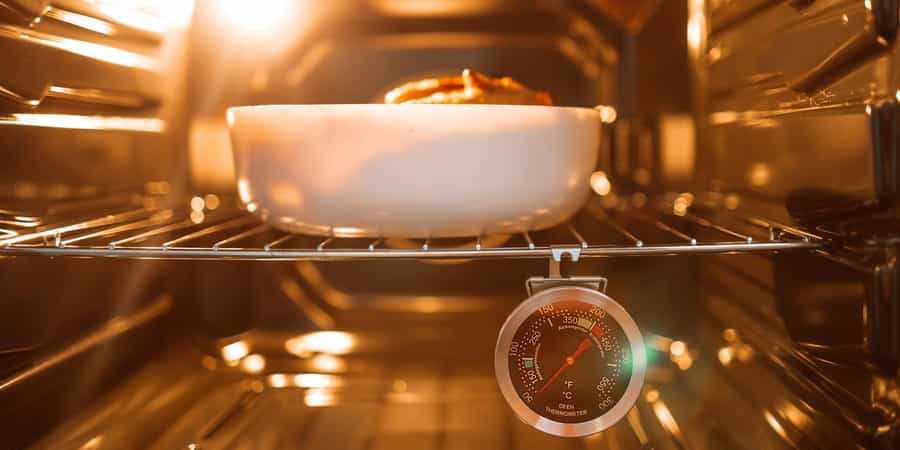
What are the benefits of a food temperature chart?
A food temperature chart can save you from any potential food safety issues. Because undercooked meat can cause gastrointestinal illness in consumers, your team must always be properly oriented and equipped with the necessary information as a preventive control.
A food temperature chart can help you fulfill this task and more:
- Reference guide: A food temperature chart can serve as a reminder and reference for your employees on how to properly cook any type of food. With all of the different types of dishes that a food establishment may have, their target internal temperatures may significantly vary. With confusion, food handlers can easily make common food safety mistakes such as getting the proper temperature wrong even with an accurate digital food thermometer. With a food internal temperature chart, your team can always double-check the information to be sure.
- Cost-saving: When foods from your food establishment are always applied with the correct standards and accurate readings for safe cooking temperature, you can be sure that your customers will not become affected by any foodborne illness. A food safety violation can be very costly, especially when trying to control them. With issues such as lawsuits and recalls, it can even be more damaging for your food business. Ensure proper cooking by using a food temperature chart as your cooking guide.
- Food safety training: As part of any food handler's training, orienting them with the correct internal temperature of the foods that you serve in your restaurant is important. You can use a food temperature chart to acquaint food handlers regarding this matter as well as the consequences of not following these standards. Your team can protect consumers with food temperature standards and accurate readings from a calibrated digital thermometer.
A food temperature chart can help your food establishment gain customer confidence through consistently serving safe food to customers. By cooking ingredients such as raw meat or ground meat, you can be sure that bacterial growth is completely stopped.
If your food establishment serves undercooked meats such as beef cooked to a medium-rare degree of doneness for the customer's personal preference, pair up this chart with a consumer advisory.
How to create a Food temperature chart
There are many available food temperature charts. You can even have one personally made for your kitchen. Despite this, you need to make sure that the chart that you will get will serve its purpose and ensure food safety in your kitchen operations. Learn what are the important elements to consider when making a food temperature chart:
- Accurate and factual: The function of this chart can prevent the effects of harmful bacteria. Proper cooking temperatures ensure that the level of foodborne bacteria and other pathogens in the food you are preparing is very low to cause any food poisoning. As such, the information that you put on your chart must be based on reliable sources such as published scientific journals and information from food safety agencies. Using inaccurate information can encourage the occurrence of foodborne illnesses. Make sure to only include proper internal cooking temperatures on your food temperature chart.
- Brief: Only include the important information that is relevant to the objective of the chart. Do not put lengthy sentences or irrelevant information such as storage temperatures as this information can be used for a different type of chart. Make sure to only include cooking recommendations for internal cooking temperatures.
- Updated: Food temperature requirements are often updated by researchers and food safety authorities. This activity is done to find more efficient ways of preparing food without sacrificing their safety. Consult your local health department for the most updated standards for food service establishments.
- Clear: As mentioned, different foods have different recommended internal temperature cooking strategies. As such, make sure that the presented information in your chart is clear and will not cause any confusion. Use bold letters, highlight important information, and provide enough space in between information.
What's an example of a food temp chart?
| Food | Type/Cuts | Internal Temperature |
|---|---|---|
| Beef, bison, veal, goat, and lamb | Steaks, roasts, chops | 145°F (63°C) Rest time: 3 minutes |
| Ground meat and sausage | 160°F (71°C) | |
| Casseroles | Meat and meatless | 165°F (74°C) |
| Chicken, turkey, and other poultry | Whole bird (including stuffing inside poultry) and individual cuts or types | 165°F (74°C) |
| Eggs | Raw eggs | Cook until yolk and white are firm |
| Egg dishes (e.g., quiche, frittata) | 160°F (71°C) | |
| Casseroles (containing meat and poultry) | 165°F (74°C) | |
| Ham | Raw ham | 145°F (63°C) and rest for 3 minutes |
| Precooked ham | 165°F (74°C) | |
| Leftovers | Any type | 165°F (74°C) |
| Pork | Steaks, roasts, chops | 145°F (63°C) and rest for 3 minutes |
| Ground meat and sausage | 160°F (71°C) | |
| Rabbit and venison | Wild or farm-raised | 160°F (71°C) |
| Seafood | Fish (whole or filet), such as salmon, tuna, tilapia, pollock, bass, cod, catfish, trout, etc. | 145°F (63°C) or cook until flesh is no longer translucent; should separate with ease using a fork |
| Shrimp, lobster, crab, and scallops | Flesh should be white (or pearly) and opaque when cooked | |
| Clams, oysters, mussels | Shells should open when cooked |
Always consider these key elements to ensure that you are only serving food without fear of causing a foodborne illness outbreak. We recommend that you use our very own Food Temperature Chart at FoodDocs.
This chart is just one of our many food safety documents that have been built with careful consideration of all the key elements of visual aids. For more concrete temperatures for meats targeting different cooking temperature categories such as beef doneness, poultry cooking, and others, you can use our plan template hub.
Monitor cooking temperatures with FoodDocs' food safety management software
At FoodDocs, our digital FSMS can help you cover every monitoring task for your employees and make sure that all food safety operations are done on time.
Switching to our digital platform even takes out the tedious task of formulating a whole FSMS for your team. In just 15 minutes, our system can automatically generate a digital FSMS tailored specifically to your food business operations so you can start logging temperatures quickly and easily.
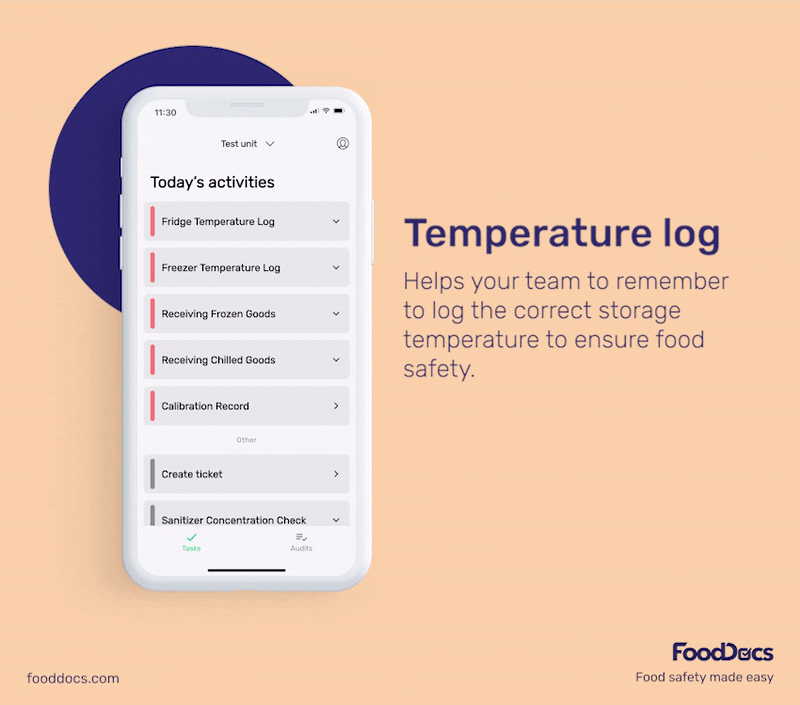
No experience with creating a food safety management system? No problem. You can easily switch to our digital platform by simply answering a few questions that describe the nature of your food business. Powered by machine learning, our system will generate the digital FSMS for you hassle-free.
With this digital FSMS you can get the following benefits:
- You can save your employees' time with digital monitoring forms that can be set to be auto-filled by our system. Using previously logged information, our system automatically fills out your monitoring forms which will only need verification.
- Never forget and get every food safety task done on time. With our mobile application, our system can send smart notifications to assigned food handlers and remind them of a food safety task that is due.
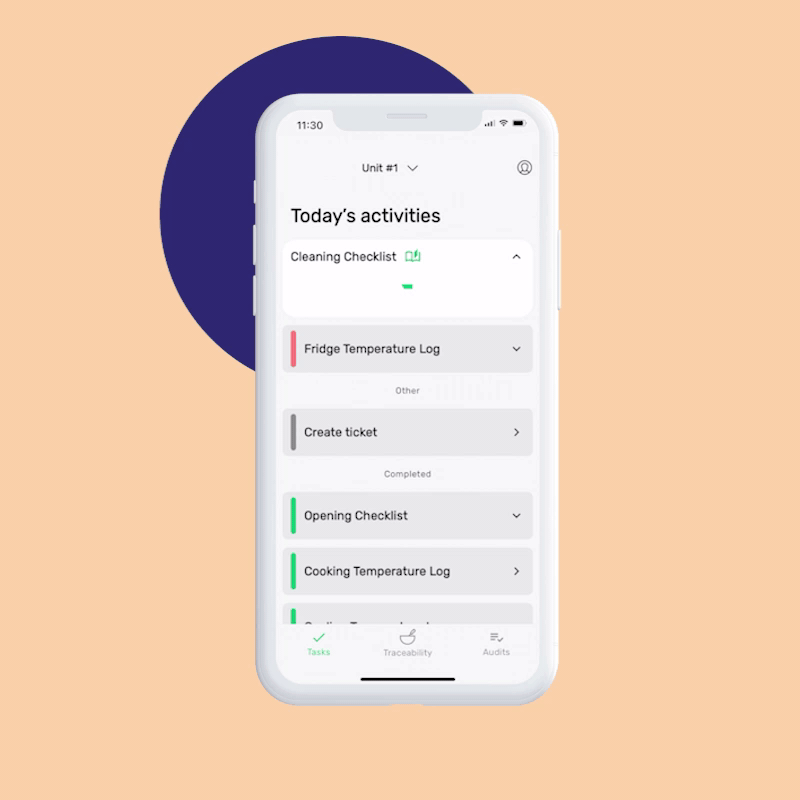
- Save at least 20% of your time from managing your food safety operations with our real-time food safety dashboard. Using this feature, you can get a quick view of your food establishment's food safety compliance and determine whether it needs improvements or is doing great.
- Get efficient cloud storage where you can easily store and access your digital files at any time. Save up on space and get organized using our system.
In addition to these benefits, choosing to go digital is a step towards a more sustainable food industry. When you use the traditional process of FSMS, you will inevitably use tons of paper with your everyday monitoring tasks. Using our digital FSMS, you get to cut all use of paper and become more efficient.
You can personally experience our digital FSMS without the commitment. Using our free, 14-day trial, you can try the features of our product and test its potential to help you maintain compliance.
Frequently asked questions about food safety temperature charts
What are the recommended safe cooking temperatures that food handlers should follow?
Our food temperature chart shows the right cooking temperatures for various foods. After cooking, food should not stay in the temperature danger zone for more than four hours. This zone is between 41°F and 135°F, where bacteria grow rapidly.
Foods generally fit into four temperature categories:
-
165°F: Poultry, stuffing with meat, stuffed meats and pastas, and dishes with previously cooked food
-
155°F: Ground meat, seafood, ostrich meat, injected/marinated/tenderized meats, and eggs for hot holding
-
145°F: Beef, pork, lamb, veal (steaks, chops, and roasts), whole seafood, and eggs served immediately
-
135°F: RTE hot-holding food as well as fruits, vegetables, grains, and legumes for hot-holding
How long can food sit out before it becomes unsafe?
Food can sit out for approximately 2 hours at room temp (or 1 hour above 90°F) before it becomes unsafe.
Do I need to rest meat after cooking, and why?
Yes, you need to rest meat (e.g., steaks, roasts, chops) for about 3 minutes after reaching 145°F because this time allows for the meat's internal temperature to stabilize and any remaining bacteria to be killed by residual heat (except for ground meat and poultry, which should simply be consumed hot).
How can I accurately check food temperatures?
You can accurately check food temperatures with a calibrated food thermometer. To properly calibrate your thermometer, you can use the freezing point method or the boiling point method.
